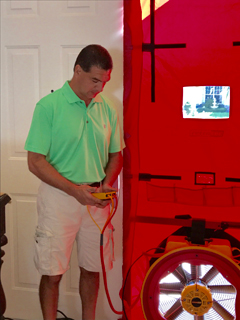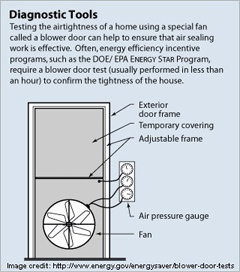Blower Door Testing


Specialized air flow and pressure measuring devices are used to monitor and analyze the complex interactions which determine building performance.
These are some reasons for establishing the proper building tightness:
Reducing energy consumption due to air leakage
Avoiding moisture condensation problems
Avoiding uncomfortable drafts caused by cold air leaking in from the outdoors
Determining how much mechanical ventilation might be needed to provide acceptable indoor air quality
Measuring house air leakage with a blower door:
Air leakage can increase heating and cooling costs over 30% and contribute to comfort, health and safety problems. Finding hidden air leakage sites, called bypasses, can be difficult without the use of a blower door. This diagnostic equipment uses a fan to pressurize (force air into) or depressurize (force air out of) a building. When the fan operates, it is easy to feel the effects of infiltration – air leaking through cracks in the building envelope. Blower doors have gauges which can measure the relative leakiness of a building.
One measure of a home’s leakage rate is air changes per hour (ACH), which estimates how many times in one hour the entire volume of air inside the building leaks to the outside. Leakier houses have higher ACH’s, therefore higher heating and cooling costs, and greater potential for moisture, comfort, and health problems.
To determine ACH50, the blower door creates a pressure difference of 50 Pascals between inside and outside. Fifty Pascals is approximately equivalent to a 20-m.p.h. wind blowing against all surfaces of a building. The leakier the house, the harder the fan must work to maintain the pressure. The amount of air the fan blows, measured in cubic feet per minute (CFM), is used to determine ACH.
Enclosure testing tested by the blower door, which sucks air into or out of the home until a standard pressure is reached (50 Pascals). Since we know how much air is flowing through the fan, we know how much is leaking through the gaps and cracks in the home’s enclosure.
The blower door’s reading will be in Cubic Feet per Minute (CFM) at 50 Pa, which can be divided by either the home’s volume or enclosure surface area to show leakage in Air Changes per Hour (ACH50) or CFM per Square Foot of Surface Area (CFM/ft2). You can also estimate the cumulative size of the hole in the enclosure. At present, ACH50 is more popular- 3 ACH50 max is the current International Energy Conservation Code (IECC) requirement that we can all easily aim for. By 2017, new homes in all 50 U.S. states must be built to 7 ACH50 or less whether they like it or not.
To schedule Blower Door Testing or any other service, contact us!
How we can help...
We offer a wide range of services. Call us at (772) 263–3265 or click the "Service Request" button to complete our easy-to-use online form.
What our Customers Say
I enjoyed working with Scott. He was knowledgeable and professional…everything I look for in a quality service person.
Janette ShearerComparing prices with Energy Raters Plus and other companies, I picked Energy Raters Plus. Scott won’t disappoint you in terms of pricing, quality service, and professionalism.
Peter BowenScott Brann and Energy Raters Plus have been great to deal with. I would highly recommend them!
Karen Delaney